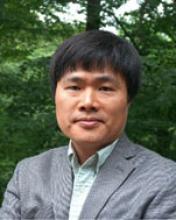Discovery Park F175
Towards the next generation of Navy technologies, unconventional materials and material processes are often considered as attractive alternatives to meet demanding performances under specific, extreme conditions. Within this broad scope, I will highlight some of the focused research topics at the NRL Multifunctional Materials Branch with a main focus on (1) dynamic cavitation in soft materials under fast loading rate conditions and (2) in situ investigations of material deformation with an emphasis on manufacturing-relevant mechanisms.
Dynamic cavitation in soft materials is becoming increasingly relevant due to emerging medical implications such as the potential of cavitation-induced brain injury or cavitation created by therapeutic medical devices. To experimentally characterize dynamic cavitation nucleation, we have recently developed an experimental instrument, called the integrated drop tower system, to quantify the critical acceleration (a_cr) that corresponds to cavitation nucleation while concurrently visualizing time evolution of cavitation. Our experimental results reveal that a_cr increases with increasing concentration of gelatin. Interestingly, we have observed the distinctive transition from a sharp increase (pure water to 1% gelatin) to a much slower (about 10 times) rate of increase between 1% and 7.5% gelatin. As a likely mechanism, we consider non-spherical bubbles in gels, which captures the experimentally observed liquid-to-gel transition in cavitation.
Electrically assisted deformation (EAD) is an emerging technique to enhance formability of metals by applying an electric current through them. However, isolating electrical and thermal effects on EAD is very difficult using macroscopic samples. Metallic sample micro- and nanostructures together with a custom test procedure have been developed to evaluate the impact of applied current on the formation without joule heating and evolution of dislocations on these samples. For example, a negligible change in temperature (<0.02 °"C" ) is predicted at ~3500 A/mm2. Utilizing the attractive features of this unique approach, we have directly investigated potential electron-dislocation interactions in single crystal copper (SCC) specimens that are simultaneously subjected to uniaxial loading and electric current density up to 5000 A/mm2. Our in situ TEM studies indicate that for SCC electroplasticity does not play a key role as no differences in dislocation activities, such as depinning and movement, are observed.

Wonmo Kang received his Ph.D. degree in Mechanical Engineering from the University of Illinois at Urbana-Champaign where he worked in the MEMS and Micromechanics laboratory under the supervision of Prof. M. Taher A. Saif. Upon completion of his degree with the Outstanding ME PhD Award, he joined Prof. Espinosa’s group at Northwestern University in 2012 as a postdoctoral research fellow. In 2014, Dr. Kang won the American Society for Engineering Education-Naval Research Laboratory Fellowship and currently supports Naval Research Laboratory with research focuses on cavitation in soft materials, in situ material characterization, nano/bio-mechanics, and NEMS/MEMS/bioMEMS. Dr. Kang has published his work in the leading scientific journals including Nano Letters, Advanced Functional Materials, Trend in Biotechnologies, Small, Nanoscale and Lab on a Chip.
